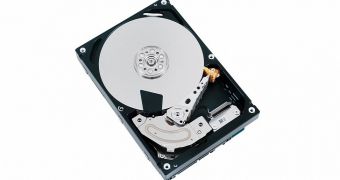Hard disk drives are all well and good, but their moving parts can be troublesome, and we aren't just talking about the noise they make. They also cause vibrations that make it unhealthy to stack them too close together.
Toshiba decided to address the problem when it designed the MD03ACA-V series of high-capacity hard disk drives (HDDs).
The answer came in the form of industry-standard 512B sector lengths and rotational vibration (RV) compensation. They should maintain performance and long life under multiple HDD configurations.
Toshiba says that the MD03ACA-V series drives are capable of running at full tilt all the time, without interruption. 24/7 as it were.
It's why the storage devices are intended for surveillance applications instead of consumer systems. In fact, the company was careful to test the things in surveillance digital video recorders (SDVR) and alternatives.
For those who want details, video surveillance can be accomplished by means of surveillance network video recorders (SNVR) and Hybrid SDVR as well.
The performance of the newcomer wasn't included in the rather short press release that Toshiba published the other day.
Between the 6 Gbps SATA III interface and 7,200 RPM (rotations per minute) platter speed, however, they should be about as fast as they can get.
Moving on, the mean time to failure (MTTF) is of 1 million hours, even when the storage units work in environments of less than ideal temperatures.
All the while, they can maintain uninterrupted write applications and stream to multiple displays and/or computers at once.
Moreover, the Toshiba MD03ACA-V series HDDs come in 2 TB, 3 TB and 4 TB. All par for the course when it comes to 3.5-inch units, though 4 TB isn't overly prevalent in the surveillance field. Something that Toshiba doesn't mind to see changed, apparently.
For those who want some numbers, the three new HDDs can work at temperatures of up to 70 degrees Celsius (158 degrees Fahrenheit) and measure 26.1 x 101.6 x 147 mm / 1.02 x 4 x 5.78 inches. Furthermore, all three possess 64 MiB FIFO ring buffer memory, an average latency time of 4.17 ms, and a power draw of 11.3 W, 6 in idle state.
Finally, the storage devices weigh 720 grams / 1.58 pounds each, and shouldn't make more noise than 31 dB. That last bit isn't that important in surveillance rooms, but it's nice to know the place won't be flooded with creaking and crackling. Not that the sound isolation usually applied to those places and computers would allow it through anyway.

 14 DAY TRIAL //
14 DAY TRIAL //